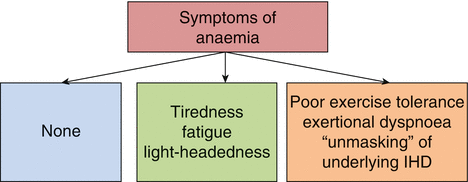and Christopher Isles2
(1)
Institute of Cardiovascular and Medical Sciences, University of Glasgow, Glasgow, UK
(2)
Dumfries and Galloway Royal Infirmary, Dumfries, UK
Anaemia is a common problem in chronic kidney disease and is associated with considerable morbidity and mortality if untreated. During the past few years effective treatment has become possible with genetically engineered erythropoiesis stimulating agents (ESAs) and intravenous iron.
Q1 What is haemoglobin and what are the normal levels?
Haemoglobin is the part of the red blood cell that carries oxygen to the tissues. Normal range for men is 135–180 g/l and women 120–160 g/l. Mildly low levels are particularly common in women. In general the body adapts well to mild chronic anaemia, causing few, if any, symptoms.
Q2 Why do patients with CKD become anaemic?
There are a number of reasons. The main one is lack of erythropoietin but a reduced red cell life span, iron deficiency, drugs and procedures also contribute (Fig. 27.1):


Fig. 27.1
Factors influencing renal anaemia
Q3 What are the symptoms of anaemia?
Tiredness, lack of energy, breathlessness on exertion, poor appetite, poor concentration, disturbed and un-refreshing sleep are all symptoms of anaemia. Symptoms are very similar to those of uraemia and indeed anaemia may be the cause of these. The presence of anaemia may worsen or unmask angina if patients have underlying ischaemic heart disease, due to reduced oxygen transport in the blood to the heart (Fig. 27.2).


Fig. 27.2
Symptoms of anaemia. The speed of onset of anaemia is clinically very important. A rapid drop = more symptoms and lower Hb = more symptoms. Patients with slowly worsening anaemia often display very few symptoms
Q4 When should you begin to investigate and treat anaemia in a patient with CKD?
As the haemoglobin falls below 110 g/l it is appropriate to determine the levels of iron, B12 and folate and replace if required. Because of concerns regarding the potential risks of ESA therapy it is not normally started until the haemoglobin drops below 100 g/l.
Box 27.1 Haemoglobin Threshold for Action
Hb <110 g/L = Investigate (see following)
Hb <100 g/L = Start ESA (if needed)
Hb >115 g/L = Suspend ESA therapy
Q5 How do you determine the likely cause or causes of anaemia in a renal patient?
Iron deficiency is the most common cause. If there is iron deficiency then GI blood loss should be considered and investigated while replacing the iron in an appropriate form. B12 and folate deficiency are less common but will respond to appropriate replacement. If iron, B12 and folate are all normal and if the reticulocyte count is low then ACEI/ARBs should be considered as possible causes of anaemia. Following a full history and examination patients should have an anaemia screen as shown in Fig. 27.3.


Fig. 27.3
Initial investigation of anaemia in renal disease
Q6 What does the serum ferritin tell us and how do we use serum ferritin to make decisions on treatment?
Serum ferritin gives a measure of the body’s iron stores. It is also an inflammatory marker which means that it rises when a patient becomes infected e.g. septicaemia or develops some other inflammatory process e.g. rheumatoid arthritis. In other words ferritin is normal or raised when iron stores are acceptable or something in the body is inflamed. Because of this it is not possible to interpret serum ferritin unless you also know the CRP (see below) which is another and perhaps better known inflammatory marker.
Q7 Why is it important to measure CRP when you measure ferritin?
CRP stands for C-reactive protein. The normal level for CRP is less than 3. CRP rises in the presence of infection e.g. septicaemia or other inflammatory processes e.g. rheumatoid arthritis. It is always best to measure CRP when you measure serum ferritin to guide the interpretation of serum ferritin, as follows:




If serum ferritin is less than 100 μ/L then body iron stores are likely to be low and the patient will respond to iron therapy.< div class='tao-gold-member'>Only gold members can continue reading. Log In or Register to continue
Stay updated, free articles. Join our Telegram channel

Full access? Get Clinical Tree








